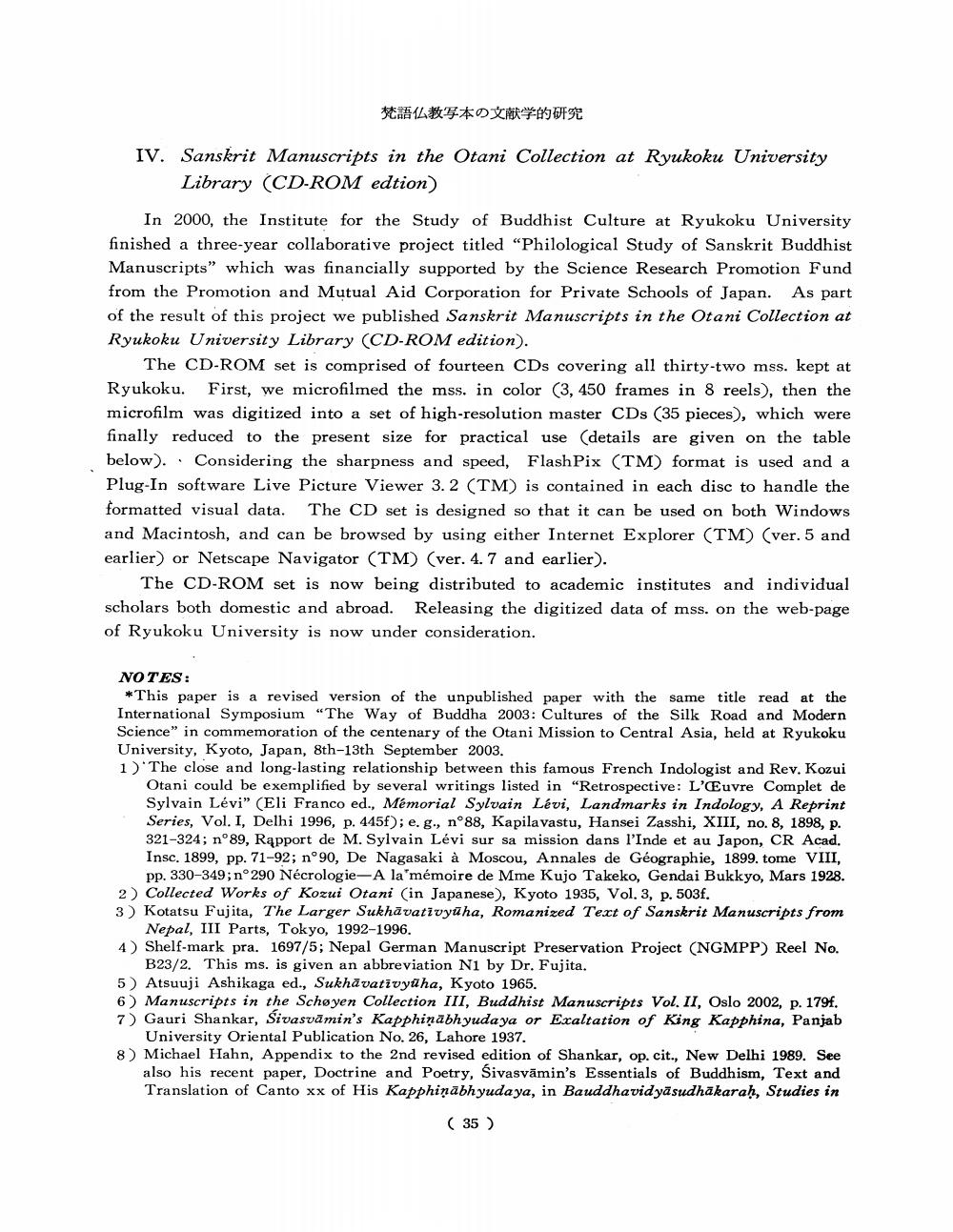________________
梵語仏教写本の文献学的研究
IV. Sanskrit Manuscripts in the Otani Collection at Ryukoku University Library (CD-ROM edtion)
In 2000, the Institute for the Study of Buddhist Culture at Ryukoku University finished a three-year collaborative project titled "Philological Study of Sanskrit Buddhist Manuscripts" which was financially supported by the Science Research Promotion Fund from the Promotion and Mutual Aid Corporation for Private Schools of Japan. As part of the result of this project we published Sanskrit Manuscripts in the Otani Collection at Ryukoku University Library (CD-ROM edition).
The CD-ROM set is comprised of fourteen CDs covering all thirty-two mss. kept at Ryukoku. First, we microfilmed the mss. in color (3, 450 frames in 8 reels), then the microfilm was digitized into a set of high-resolution master CDs (35 pieces), which were finally reduced to the present size for practical use (details are given on the table below). Considering the sharpness and speed, FlashPix (TM) format is used and a Plug-In software Live Picture Viewer 3.2 (TM) is contained in each disc to handle the formatted visual data. The CD set is designed so that it can be used on both Windows and Macintosh, and can be browsed by using either Internet Explorer (TM) (ver. 5 and earlier) or Netscape Navigator (TM) (ver. 4.7 and earlier).
The CD-ROM set is now being distributed to academic institutes and individual scholars both domestic and abroad. Releasing the digitized data of mss. on the web-page of Ryukoku University is now under consideration.
NOTES:
*This paper is a revised version of the unpublished paper with the same title read at the International Symposium "The Way of Buddha 2003: Cultures of the Silk Road and Modern Science" in commemoration of the centenary of the Otani Mission to Central Asia, held at Ryukoku University, Kyoto, Japan, 8th-13th September 2003.
1) The close and long-lasting relationship between this famous French Indologist and Rev. Kozui Otani could be exemplified by several writings listed in "Retrospective: L'Euvre Complet de Sylvain Lévi" (Eli Franco ed., Mémorial Sylvain Lévi, Landmarks in Indology, A Reprint Series, Vol. I, Delhi 1996, p. 445f); e. g., n°88, Kapilavastu, Hansei Zasshi, XIII, no. 8, 1898, p. 321-324; n°89, Rapport de M. Sylvain Lévi sur sa mission dans l'Inde et au Japon, CR Acad. Insc. 1899, pp. 71-92; n°90, De Nagasaki à Moscou, Annales de Géographie, 1899. tome VIII, pp. 330-349; n°290 Nécrologie-A la mémoire de Mme Kujo Takeko, Gendai Bukkyo, Mars 1928. 2) Collected Works of Kozui Otani (in Japanese), Kyoto 1935, Vol. 3, p. 503f.
3) Kotatsu Fujita, The Larger Sukhāvativyuha, Romanized Text of Sanskrit Manuscripts from Nepal, III Parts, Tokyo, 1992-1996.
4) Shelf-mark pra. 1697/5; Nepal German Manuscript Preservation Project (NGMPP) Reel No. B23/2. This ms. is given an abbreviation N1 by Dr. Fujita.
5) Atsuuji Ashikaga ed., Sukhāvativyuha, Kyoto 1965.
6) Manuscripts in the Schøyen Collection III, Buddhist Manuscripts Vol. II, Oslo 2002, p. 179f. 7) Gauri Shankar, Sivasvamin's Kapphinabhyudaya or Exaltation of King Kapphina, Panjab
University Oriental Publication No. 26, Lahore 1937.
8) Michael Hahn, Appendix to the 2nd revised edition of Shankar, op. cit., New Delhi 1989. See also his recent paper, Doctrine and Poetry, Śivasvamin's Essentials of Buddhism, Text and Translation of Canto xx of His Kapphiṇābhyudaya, in Bauddhavidyasudhakaraḥ, Studies in
( 35 )




